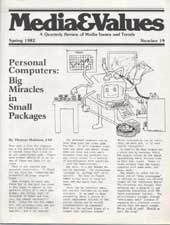Personal Computers: Big Miracles in Small Packages
|
This article originally appeared in Issue# 19
|
Once upon a time the computer was a big machine with millions of vacuum tubes that lived in an air conditioned room. People were either afraid of it or in awe of those who knew its secrets
Then it got smaller and sprouted transistors. It found its way into the "computing departments" of large corporations.
Some thought it would stay there but in the past few years it has begun to appear in the upstairs office of a small publisher, the living rooms of thousands of homes and even, yes, the church secretary's desk. Along the way the computer, now personal-size, has gotten a lot friendlier, a lot smaller... and a lot smarter.
The personal computer can do more than play the video game, Pac-Man. It will remember every cent you spent and where, every name you know and each one's favorite food and greatest talent, every answer to a battery of psychological test questions…and the implications.
But wait, it's not Wonder Woman or Superman. The proverbial 'garbage in, garbage out" still applies. The data we flawed human beings have at hand are what IBM and Apple have for lunch.
There can be incorrect data, but useless information is more sinister. Do we need to know everything about a person because employment records or the parish census can be stored electronically on computer? What are the salient items of a budget that indicate trends?
While information can be invisible, we must ask, is it ever really intangible?
It used to be that Utopia was a place run by machines while the people lolled on the beach, squandering their leisure time as best they could. Today it seems evident that the brainy computer will make more, not less, work.
The chance to learn the tedious job of "data processing" is offered to every out-of-work viewer of the "Afternoon Movie" The secretary who thought that Xeroxing was a miracle is now supplying executives with 300 "word processed" letters. The decision-maker ploughs through "electronic mail" instead of engaging in a pleasant conversation over the water cooler. Where will it end? Should we pull the plug?
No, the computer can be harnessed. If we know the job we want done, we can purchase the right programming. That's also called "software." And from there it's onto the computer it self, the "hardware." An investment of between $7000 and $l5,000 may seem high to someone who just wants mailing lists, but it is reasonable if financial records, personal data files, resource inventories and letter-perfect typing are included.
The next question to be answered is 'Who will use this inforriation? Especially in the small organization, school or church, it's amazing what can happen when people get their hands on "good" information. But will user training programs be available for key members of a school staff or parish council? Or will pastors or executives keep it as a personal ego trip or intimidate other users not to "break" it?
Used properly, however, the school budget can get a shot in the arm when it's clear that 48% of the due tuition has not been collected. Or suddenly the elderly lady who filled out a census card in June gets a call because she wanted transportation to church. The name of the game is letting the computer remember and display the information and letting the people take responsibility for the action.
Depending on the way we use the computer, it can build walls or bridges. To connect up the right people with the right services to utilize available talents for current needs, that's the promise of the computer...and the challenge.



